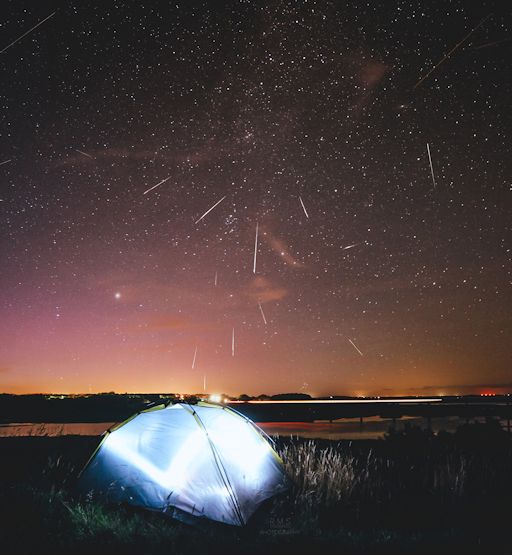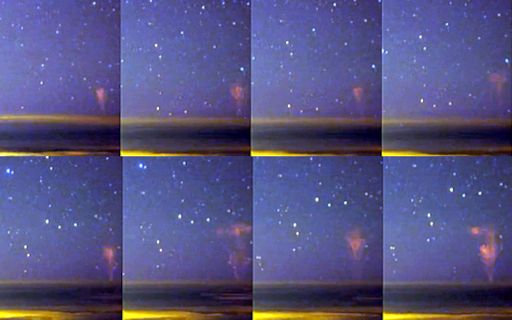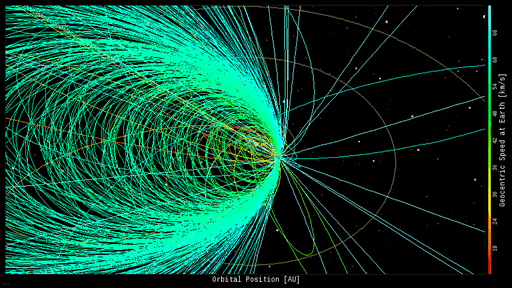Learn to photograph Northern Lights like a pro. Sign up for Peter Rosen's Aurora Photo Courses in Abisko National Park, winner of the TripAdvisor Certificate of Excellence Award 2015. | | |
PERSEID METEOR SHOWER: Last night's Perseid meteor shower put on a fine display. NASA's all sky network ofmeteor cameras detected more than 300 Perseid fireballs over the USA alone. Elsewhere, observers working with the International Meteor Organization counted as many as 100 meteors per hour from dark-sky sites around the world. Here is an example from a campsite in Nykøbing Mors, Denmark:

"This was the best night in my whole astrophotography experience," reports photographer Ruslan Merzlyakov. "The Danish night sky was absolutely clear during the special sky event! Lots of Perseids and Northern Lights exploded in the sky right over my hometown. For once I am not going to argue with Danish weather, because I am 200% happy!"
The show isn't over yet. Earth is still inside a stream of debris from comet 109P/Swift-Tuttle, the source of the Perseids. Rates will probably decrease on the night of August 13-14, but not to zero. No matter where you live, the best time to look is during the dark hours before sunrise on Friday.
Realtime Meteor Photo Gallery
SPRITES ABOVE HURRICANE HILDA: On August 10th, the National Weather Service reported an intense outburst of lightning from Hurricane Hilda in the Pacific Ocean. Steve Cullen lives in Waikoloa, Hawaii, where the storm is heading, and when he heard the report he had an idea. Cullen explains: "I wondered if the storm was close enough to be captured by the Canada France Hawaii Telescope CloudCam atop Maunakea. After sunset I logged on to the CloudCam site to check the most recent two-hour timelapse loop, and sure enough, WE HAD SPRITES!!!" Here are some frames from the video:

Sprites are a strange and beautiful form of lightning that shoot up from the tops of electrical storms. They reach all the way up to the edge of space alongside meteors, auroras, and noctilucent clouds. Some researchers believe cosmic rays help trigger sprites, but this is controversial. In short, sprites are a true space weather phenomenon.
As awareness of sprites has increased in recent years, photographers have started to catch them dancing atop ordinary thunderstorms on a regular basis: photo gallery. Seeing sprites above a hurricane, however, is rare. Most hurricanes don't even have regular lightning because the storms lack a key ingredient for electrical activity: vertical winds. (For more information read the Science@NASA article "Electric Hurricanes" by Patrick Barry and Dr.Tony Phillips.) Clearly, Hurricane Hilda is not a typical storm.
Stay tuned for more observations of Hilda's cloudtops as it approaches Hawaii.
Realtime Sprite Photo Gallery
SOLAR RADIO BURSTS: For the past week, solar activity has been low. However, the sun has not been quiet. "I have noted that the sun has been extremely dynamic at shortwave radio wavelengths with almost constant Type III bursting," reports Thomas Ashcraft of New Mexico. He has been hearing loud bursts of static coming from the loudspeaker of his amateur radio telescope whenever he points it at the sun. Click on the dynamic spectrum below to hear a sample:

Type III solar radio bursts are caused by solar flares. Electrons accelerated by strong flares race through the sun's atmosphere, causing a ripple of plasma waves and radio static. Yet, ironically, there have been no strong solar flares. Nevertheless, suggests Ashcraft, "all of the bursting indicates a lot of magnetic complexity and movement in the sunspots."
The biggest sunspot of all, AR2396, is about to rotate off the western edge of the sun. After it departs, the static might subside. Until then, shortwave radio operators should remain alert for solar bursts. The sun is not so quiet, after all. Solar flare alerts: text or voice
Realtime Space Weather Photo Gallery
Realtime Venus Photo Gallery
Realtime Aurora Photo Gallery
Realtime NLC Photo Gallery
Every night, a network of NASA all-sky cameras scans the skies above the United States for meteoritic fireballs. Automated software maintained by NASA's Meteoroid Environment Office calculates their orbits, velocity, penetration depth in Earth's atmosphere and many other characteristics. Daily results are presented here on Spaceweather.com.
On Aug. 13, 2015, the network reported 381 fireballs.
(342 Perseids, 35 sporadics, 2 Southern Delta Aquariids, 1 Southern iota Aquariid, 1 kappa Cygnid)

In this diagram of the inner solar system, all of the fireball orbits intersect at a single point--Earth. The orbits are color-coded by velocity, from slow (red) to fast (blue). [Larger image] [movies]
Potentially Hazardous Asteroids (
PHAs) are space rocks larger than approximately 100m that can come closer to Earth than 0.05 AU. None of the known PHAs is on a collision course with our planet, although astronomers are finding
new ones all the time.
On August 13, 2015 there were potentially hazardous asteroids.
Notes: LD means "Lunar Distance." 1 LD = 384,401 km, the distance between Earth and the Moon. 1 LD also equals 0.00256 AU. MAG is the visual magnitude of the asteroid on the date of closest approach. | | The official U.S. government space weather bureau |
| | The first place to look for information about sundogs, pillars, rainbows and related phenomena. |
| | Researchers call it a "Hubble for the sun." SDO is the most advanced solar observatory ever. |
| | 3D views of the sun from NASA's Solar and Terrestrial Relations Observatory |
| | Realtime and archival images of the Sun from SOHO. |
| | from the NOAA Space Environment Center |
| | the underlying science of space weather |
| | Web-based high school science course with free enrollment |

